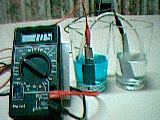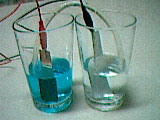


|
Daniell electrochemical battery
Science at Home |
||
|
Materials
|
Compounds
|
Videos:
download2.avi (230 KB) Salt bridge Pictures: 

|
|
Procedure
1. Attention! During the execution of this experiment you should protect your hands with gloves and eyes with glasses. 2. Begin preparing an aqueous solution of sodium chloride for the saline bridge. 3. Pour the aqueous solution of salt in a rubber tube and cover the other tube extremities with cotton. (the cotton should be placed to don't allow the solution of NaCl to come out. It shouldn't be visible any air bubble in the tube) 4. Fill 2/3 of the glasses total volume with distilled water. 5. Pour a spoon of copper sulphate in the first glass and a spoon of zinc sulphate in the second. Mix the solutions well. 6. Using a conductive string with crocodiles in the extremities, link the zinc electrode to the black string (COM) of the voltmeter. 7. With the other string, link the red string of the voltmeter to the copper electrode. 8. Dip each one of the extremities of the saline bridge in the solutions of zinc and copper sulphate. (the system doesn't work if the saline bridge is not well dived) 9. Dip the zinc electrode in the zinc sulphate solution. (be careful with the zinc sulphate because it is nocive) 10. Dip the copper electrode in the copper sulphate solution. (you can verify that the voltmeter presents a potential close to 1,1 V) |
||
|
Why?
In the Daniell battery, the copper electrode (cathode) attracts electrons from the zinc electrode (anode). These electrons flow in the electric circuit. As soon as the copper electrode receives the electrons, the Cu2+ ions present in the copper sulphate solution approach to the electrode to equilibrate the negative loads. When the Cu2+ ions reach the surface of the copper, they react with two electrons, depositing in the electrode under the metal form. On the other hand, for each deposited copper ion, a Zn++ is freed from the zinc electrode to the zinc sulphate solution. As well as for any battery, the Daniell battery doesn't last forever. In fact, the production of electric current decreases as the concentration of the zinc electrolyte increases and the copper electrolyte decreases. In the particular case of the saline bridge, the function of it is to allow the transport of charges from one electrolyte to the other. As it is accumulating positive charges (Zn++ in the zinc sulphate electrolyte, the Cl- of the NaCl aqueous solution compensates it swinging charges. Therefore, the concentration gradients (polarization) are minimized at least for the initial instants. |
||
 |
No part of this website can be reproduced without previous authorization. Please inform me if there is any problem with the website. |